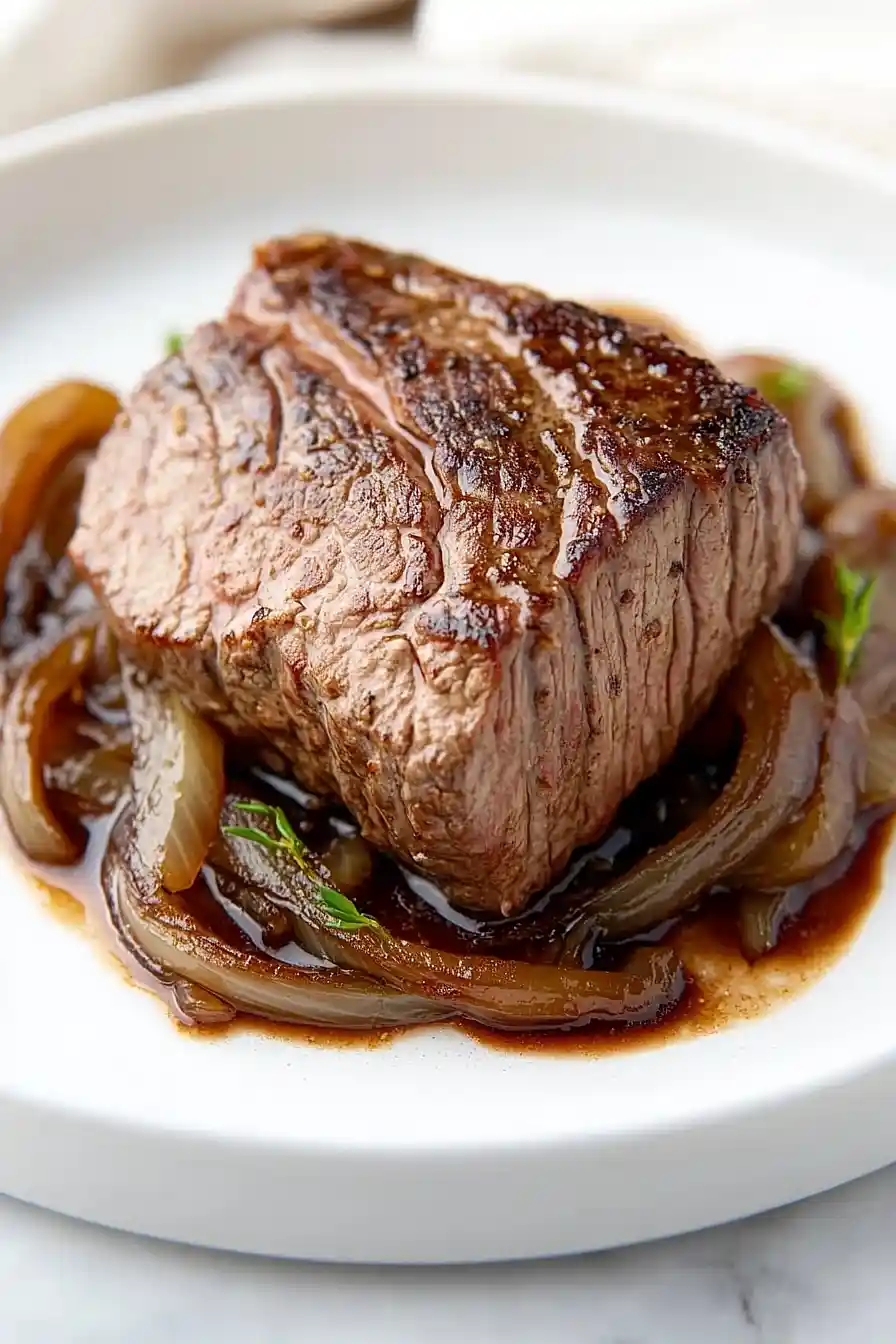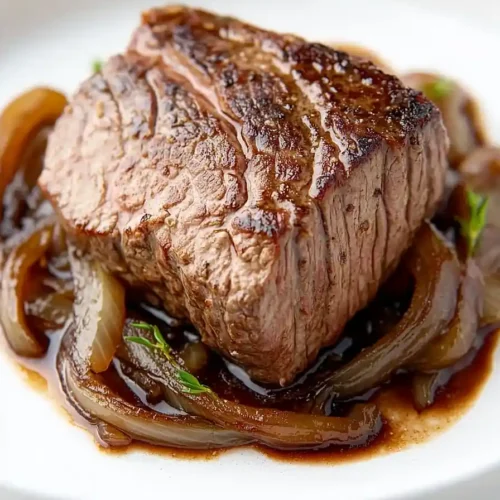I never thought about putting yakitori sauce on steak until I had it at a Japanese steakhouse last year. The waiter recommended it, and I figured why not try something different. One bite and I was hooked.
The sweet and savory flavors of yakitori sauce work so well with filet mignon. It’s not what you’d expect, but that’s what makes it good. The sauce has that perfect balance of soy sauce, mirin, and a touch of sweetness that makes the beef taste even better without covering up its flavor.

Why You’ll Love This Filet Mignon
- Restaurant-quality at home – This recipe brings the elegance of a high-end steakhouse right to your dinner table with tender filet mignon and a unique yakitori glaze.
- Unique flavor combination – The sweet chestnut honey and savory yakitori sauce create an unexpected but delicious twist on classic steak that will impress your guests.
- Perfect for special occasions – Whether it’s date night, an anniversary, or entertaining friends, this dish feels fancy enough for any celebration.
- Simple cooking technique – Despite the gourmet results, the cooking method is straightforward – just sear the steak and finish with the flavorful sauce.
What Kind of Filet Mignon Should I Use?
When shopping for filet mignon, look for steaks that are about 1 to 1.5 inches thick for the best results with this recipe. You can buy individual steaks or ask your butcher to cut a whole tenderloin into portions – both work great. The key is making sure your steaks are roughly the same thickness so they cook evenly. If you’re on a budget, you can substitute with beef tenderloin medallions, which are essentially the same cut but often cost a bit less. Just make sure to bring your steaks to room temperature about 30 minutes before cooking for the most even results.

Options for Substitutions
This recipe has some room for swaps, though I’d recommend keeping the filet mignon as is for the best results:
- Filet mignon: While filet mignon gives you that tender, melt-in-your-mouth texture, it’s pricey. If you need a substitute, try ribeye or strip steak – just adjust cooking time since these cuts are a bit thicker and have more marbling.
- Chestnut honey: Regular honey works perfectly fine here. You could also use maple syrup, though it will give a slightly different flavor profile to the dish.
- Yakitori sauce: If you can’t find yakitori sauce, make your own by mixing 3 tablespoons soy sauce, 1 tablespoon mirin, and 1 teaspoon sugar. Teriyaki sauce also works as a quick substitute.
- Dried apricots: Dried figs, dates, or even golden raisins can step in for the apricots. Just cut them to similar sizes so they cook evenly.
- Lemon zest: Orange zest makes a nice alternative and pairs well with the sweet elements in this dish. Lime zest works too if that’s what you have on hand.
Watch Out for These Mistakes While Cooking
The biggest mistake when cooking filet mignon is not letting it come to room temperature before cooking, which leads to uneven cooking with a cold center and overcooked edges – take it out of the fridge 30-45 minutes beforehand.
Another common error is moving the steak around too much in the pan, so resist the urge to flip it constantly and let it develop a proper sear by leaving it undisturbed for 3-4 minutes per side.
Since filet mignon is such a lean cut, overcooking will turn this expensive piece of meat into shoe leather – use a meat thermometer and aim for 130°F for medium-rare, remembering that the temperature will continue to rise as it rests.
Don’t forget to let your steak rest for at least 5 minutes after cooking, which allows the juices to redistribute throughout the meat, and be careful not to burn the honey in your yakitori glaze by adding it toward the end of cooking when the heat is lower.

What to Serve With Filet Mignon?
This sweet and savory filet mignon pairs beautifully with simple roasted or mashed potatoes to let the yakitori sauce really shine. I love serving it alongside steamed jasmine rice or even some buttery egg noodles to soak up all that delicious honey-glazed sauce. A crisp green salad with cucumber and radishes helps balance out the richness of the beef, or you could go with some lightly sautéed green beans or asparagus. For an Asian-inspired twist that complements the yakitori flavors, try serving it with some stir-fried bok choy or shiitake mushrooms on the side.
Storage Instructions
Refrigerate: Leftover filet mignon with yakitori sauce keeps well in the fridge for up to 3 days in an airtight container. The meat stays tender and the sauce flavors actually get even better overnight. I like to slice any leftover steak thin and use it for quick stir-fries or grain bowls during the week.
Freeze: You can freeze the cooked steak for up to 2 months, though the texture won’t be quite as tender as fresh. Wrap individual portions tightly in plastic wrap, then place in a freezer bag. The yakitori sauce freezes beautifully and helps protect the meat from freezer burn.
Warm Up: Gently warm leftover steak in a skillet over low heat with a splash of water or extra yakitori sauce to prevent it from drying out. You can also slice it thin and add it to a warm salad or pasta dish. Avoid microwaving on high heat as it can make the filet tough.
| Preparation Time | 180-240 minutes |
| Cooking Time | 30-40 minutes |
| Total Time | 210-280 minutes |
| Level of Difficulty | Medium |
Estimated Nutrition
Estimated nutrition for the whole recipe (without optional ingredients):
- Calories: 1200-1350
- Protein: 85-95 g
- Fat: 55-65 g
- Carbohydrates: 90-105 g
We'll Pay You $5 to Try This Recipe!
Cook our recipe, snap some photos, and earn a $5 Amazon Gift Card. It's that simple!
Here's how:
- Make the recipe
- Take nice pictures of your final dish
- Fill out our quick form (2 minutes max!)
- Your $5 reward is on the way!
Ingredients
For the marinade:
- 2 tbsp chestnut honey
- 3 tbsp yakitori sauce
For the meat and sauce:
- 1.1 lb filet mignon
- 1 tbsp oil
- 1 tbsp butter
- 1 onion, chopped finely
- Zest from 1 lemon, julienned
- 6 dried apricots, julienned
- 1 tbsp vinegar
For serving:
- Potatoes, for accompaniment
Step 1: Prepare the Honey Yakitori Marinade
- 2 tbsp chestnut honey
- 3 tbsp yakitori sauce
In a small bowl, combine the chestnut honey and yakitori sauce.
If the honey is too thick to mix well, warm it slightly until it blends easily.
Stir until smooth.
Step 2: Marinate the Filet Mignon
- 1.1 lb filet mignon
- honey and yakitori marinade from Step 1
Coat the filet mignon thoroughly with the prepared honey and yakitori marinade from Step 1.
Cover the marinated meat with cling film and let it rest at room temperature for 3 hours to absorb the flavors.
Step 3: Brown the Filet Mignon
- 1 tbsp oil
- 1 tbsp butter
- marinated filet mignon from Step 2
Heat the oil and butter together in a heavy-bottomed casserole dish over medium-high heat.
Once the mixture is hot and foamy, add the marinated filet mignon from Step 2 and brown it on all sides for a golden crust.
Remove the browned filet mignon and set it aside on a serving dish.
Step 4: Prepare the Aromatic Sauce Base
- 1 onion, chopped finely
- zest from 1 lemon, julienned
- 6 dried apricots, julienned
If there’s not enough fat left in the casserole, add a little more if needed.
Add the finely chopped onion and cook over medium heat until soft and translucent.
Stir in the julienned lemon zest and mix well, followed by the julienned dried apricots.
Sauté all together for 2-3 minutes to combine the flavors.
Step 5: Simmer and Finish the Sauce
- 1 tbsp vinegar
- chestnut honey (leftover from Step 1)
- yakitori sauce (leftover from Step 1)
Add the vinegar along with another splash of chestnut honey and yakitori sauce to the onion, lemon, and apricot mixture.
Stir to combine, then cover and simmer for a few minutes until the mixture thickens slightly.
I like to taste and add a touch more honey for sweetness at this point if the sauce needs more balance.
Step 6: Finish Cooking the Filet Mignon
- browned filet mignon from Step 3
- sauce from Step 5
Return the browned filet mignon from Step 3 to the casserole dish on top of the thickened sauce.
Cover and let cook over low to medium heat for 7 minutes.
Flip the filet mignon, cover again, and cook for another 7 minutes to ensure even cooking.
Remove from the heat and let rest, covered loosely with aluminum foil.
Step 7: Serve the Filet Mignon with Potatoes
- potatoes, for accompaniment
Slice the rested filet mignon and serve it with the sauce spooned on top.
Accompany with either potatoes cooked in the field or creamy mashed potatoes, as preferred.
For extra freshness, I sometimes garnish with a bit of extra lemon zest.

Irresistible Filet Mignon with Yakitori Sauce
Ingredients
For the marinade:
- 2 tbsp chestnut honey
- 3 tbsp yakitori sauce
For the meat and sauce:
- 1.1 lb filet mignon
- 1 tbsp oil
- 1 tbsp butter
- 1 onion, chopped finely
- zest from 1 lemon, julienned
- 6 dried apricots, julienned
- 1 tbsp vinegar
For serving:
- potatoes, for accompaniment
Instructions
- In a small bowl, combine the chestnut honey and yakitori sauce. If the honey is too thick to mix well, warm it slightly until it blends easily. Stir until smooth.
- Coat the filet mignon thoroughly with the prepared honey and yakitori marinade from Step 1. Cover the marinated meat with cling film and let it rest at room temperature for 3 hours to absorb the flavors.
- Heat the oil and butter together in a heavy-bottomed casserole dish over medium-high heat. Once the mixture is hot and foamy, add the marinated filet mignon from Step 2 and brown it on all sides for a golden crust. Remove the browned filet mignon and set it aside on a serving dish.
- If there's not enough fat left in the casserole, add a little more if needed. Add the finely chopped onion and cook over medium heat until soft and translucent. Stir in the julienned lemon zest and mix well, followed by the julienned dried apricots. Sauté all together for 2-3 minutes to combine the flavors.
- Add the vinegar along with another splash of chestnut honey and yakitori sauce to the onion, lemon, and apricot mixture. Stir to combine, then cover and simmer for a few minutes until the mixture thickens slightly. I like to taste and add a touch more honey for sweetness at this point if the sauce needs more balance.
- Return the browned filet mignon from Step 3 to the casserole dish on top of the thickened sauce. Cover and let cook over low to medium heat for 7 minutes. Flip the filet mignon, cover again, and cook for another 7 minutes to ensure even cooking. Remove from the heat and let rest, covered loosely with aluminum foil.
- Slice the rested filet mignon and serve it with the sauce spooned on top. Accompany with either potatoes cooked in the field or creamy mashed potatoes, as preferred. For extra freshness, I sometimes garnish with a bit of extra lemon zest.

